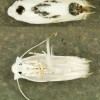 The erythrina leafminer is a member of the genus Leucoptera, which are leaf borers that can cause severe damage to plant crops, such as coffee or apples. Even though these moths are 1/20 to 1/10 the size of an average moth, they can cause serious damage. Leucoptera erythrinella is a pest of the coral bean and other members of the genus Erythrina. The larvae feed inside the leaves, making elaborate and characteristic mines, which from a distance appear to be discolorations of the leaf itself. This 5-page fact sheet was written by Andrei Sourakov, and published by the UF Department of Entomology and Nematology, January 2014.
The erythrina leafminer is a member of the genus Leucoptera, which are leaf borers that can cause severe damage to plant crops, such as coffee or apples. Even though these moths are 1/20 to 1/10 the size of an average moth, they can cause serious damage. Leucoptera erythrinella is a pest of the coral bean and other members of the genus Erythrina. The larvae feed inside the leaves, making elaborate and characteristic mines, which from a distance appear to be discolorations of the leaf itself. This 5-page fact sheet was written by Andrei Sourakov, and published by the UF Department of Entomology and Nematology, January 2014.
http://edis.ifas.ufl.edu/in1023
Tag: Andrei Sourakov
Erythrina moths Terastia meticulosalis Guenée and Agathodes designalis Guenée (Insecta: Lepidoptera: Crambidae: Spilomelinae) (EENY516/IN921)
The little known Erythrina moths represent a remarkable case of niche partitioning. In Florida these two species feed on plants of the genus Erythrina (Fabaceae), including the coral bean, Erythrina herbacea, which is native to North Central Florida and is frequently used as an ornamental. This 10-page fact sheet was written by Andrei Sourakov, and published by the UF Department of Entomology and Nematology, February 2012.
http://edis.ifas.ufl.edu/in921
Fall webworm, Hyphantria cunea (Drury) (Insecta: Lepidoptera: Arctiidae: Arctiinae) (EENY486/IN878)
This 9-page illustrated fact sheet describes this pest whose larvae form large tents in the foliage of many ornamental trees & shrubs, and also agronomic crops — synonymy, distribution, description and life cycle, hosts, economic importance, and management. Includes references. Written by Andrei Sourakov and Thomson Paris, Published by the UF Department of Entomology and Nematology as part of the Featured Creatures collection, December 2010.
http://edis.ifas.ufl.edu/in878
EENY458/IN828 Viceroy butterfly Limenitis archippus (Cramer) (Lepidoptera: Nymphalidae: Limenitidinae)
EENY-458, a 5-page illustrated fact sheet by Andrei Sourakov, is part of the Featured Creatures collection. It describes this black butterfly with white vertical stripes, which is similar to, but smaller than, the monarch butterfly — its synonymy, distribution, description, life cycle, hosts and economic importance. Includes references. Published by the UF Department of Entomology and Nematology, June 2009.
http://edis.ifas.ufl.edu/IN828
EENY-442/IN780 Monarch Butterfly, Danaus plexippus Linnaeus (Lepidoptera: Nymphalidae: Danainae)
EENY-442, a 9-page illustrated fact sheet by Andrei Sourakov, is part of the Featured Creatures collection. It describes this well-known migrating butterfly with charismatic appearance, their distribution, description, biology and life cycle, hosts and monarch toxicity, conservation status, and natural enemies. Includes references. Published by the UF Department of Entomology and Nematology, November 2008.
http://edis.ifas.ufl.edu/IN780
EENY-441/IN782 White M hairstreak, Parrhasius m-album (Boisduval & LeConte) (Insecta: Lepidoptera: Lycaenidae: Theclinae)
EENY-441, a 4-page illustrated fact sheet by Andrei Sourakov, is part of the Featured Creatures collection. It describes this metallic blue Neotropical hairstreak with characteristic M-shaped pattern on its silver-colored underside which flies in clearings and edges of oak growth — its distribution, biology and lifecycle, and hosts. Includes references. Published by the UF Department of Entomology and Nematology, November 2008.
http://edis.ifas.ufl.edu/IN782